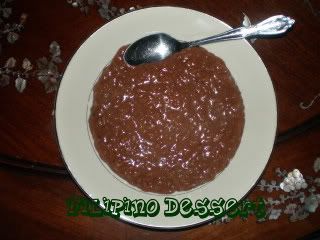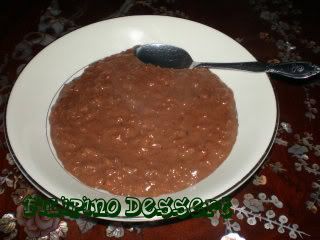Champurado
 I hear many people allude to globalization emerging with the advent of technology. With the invention of Internet and computers, people are connected with each other around the globe and able to share information, objects, emotions, and food. In the United States, when it comes to food, it is as if only recently has many Americans expanded their taste palate. Fifteen years ago when I arrived in California, Mexican food means burrito from Taco Bell, Chinese food equals fried rice, Filipino food is adobo and only a few have tasted Indian food. There were few Filipino markets in Bay Area selling staple food such as rice, fish, sinigang mix in a sachet. In those stores, it was not difficult to find sticky rice or malagkit na bigas. For this reason, champurado has always been in my kitchen in California.
I hear many people allude to globalization emerging with the advent of technology. With the invention of Internet and computers, people are connected with each other around the globe and able to share information, objects, emotions, and food. In the United States, when it comes to food, it is as if only recently has many Americans expanded their taste palate. Fifteen years ago when I arrived in California, Mexican food means burrito from Taco Bell, Chinese food equals fried rice, Filipino food is adobo and only a few have tasted Indian food. There were few Filipino markets in Bay Area selling staple food such as rice, fish, sinigang mix in a sachet. In those stores, it was not difficult to find sticky rice or malagkit na bigas. For this reason, champurado has always been in my kitchen in California.  Champurado is a Filipino dessert that unfortunately was not originally developed in Philippines. I learn that we share champurado with Mexican foodies. I was driving one day in the pockets of Los Angeles and I saw a taqueria with a huge banner that says "hot champurado for breakfast served here." I was shook by surprise and I had to actually pull over as I was not wearing my glasses to make sure I read the sign correctly. It turned out that I did not misread. By gullie, I was disappointed to find that champurado is not authentically Filipino. Though I could not trace back to the beginnings of champurado, I know that somewhere along Spanish colonization, Arab, Chinese, India, Malay migration, and Japanese invasion, champurado arrived in Philippines as a dessert/breakfast. This leads me to another question: Who said globalization just started? Globalization started a long time ago. Philippines and champurado are a manifestation of globalization that existed hundred of years ago. Although computers were not existent, many people from different nations have arrived in Philippines to trade goods in a fashion modernly stated as "up rise of globalization." With them, they brought champurado--sticky rice cooked in water with dutch processed cocoa powder, sugar, and milk. A modern version of champurado included in my recipe has 1 tsp of vanilla and cinnamon for dusting. In my short trip in Los Angeles, I learn that champurado is not originally Filipino and I learn to share what I thought was originally mine as a Filipino with other cultures who have brought champurado hundred of years ago in Philippines.
Champurado is a Filipino dessert that unfortunately was not originally developed in Philippines. I learn that we share champurado with Mexican foodies. I was driving one day in the pockets of Los Angeles and I saw a taqueria with a huge banner that says "hot champurado for breakfast served here." I was shook by surprise and I had to actually pull over as I was not wearing my glasses to make sure I read the sign correctly. It turned out that I did not misread. By gullie, I was disappointed to find that champurado is not authentically Filipino. Though I could not trace back to the beginnings of champurado, I know that somewhere along Spanish colonization, Arab, Chinese, India, Malay migration, and Japanese invasion, champurado arrived in Philippines as a dessert/breakfast. This leads me to another question: Who said globalization just started? Globalization started a long time ago. Philippines and champurado are a manifestation of globalization that existed hundred of years ago. Although computers were not existent, many people from different nations have arrived in Philippines to trade goods in a fashion modernly stated as "up rise of globalization." With them, they brought champurado--sticky rice cooked in water with dutch processed cocoa powder, sugar, and milk. A modern version of champurado included in my recipe has 1 tsp of vanilla and cinnamon for dusting. In my short trip in Los Angeles, I learn that champurado is not originally Filipino and I learn to share what I thought was originally mine as a Filipino with other cultures who have brought champurado hundred of years ago in Philippines.

1 shared:
Yes, our Mexican brothers make champurrado, and it is "Mexican," but our champurado is Filipino, it is definitely Filipino. I don't know if you actually tasted the champurrado of the Mexicans, but it is not made with rice, but rather with corn, ground corn, that is soaked and treated with lime, and then ground- the same corn preparation that would eventually turn into tamales (of which we in the Philippines have our own form as well), and also the tortilla de maiz. As for the dutch process cocoa, both Mexicans and Filipinos tradtionally do not use the dutch process which removes much of the fat from the cocoa mass. Mexicans and Filipinos both grind the whole bean, which is first roasted and then ground on a warmed grinder made of stone. This produces a much different flavor of chocolate than the dutch process. Colonization did force the Philippines, as it did Mexico, into a globalized economy, and in that experience we not only had an exchange of goods, namely food (did you know that in some of the Pacific states of Mexico there are recipes for ginitaan- something that definitely originated in the Philippines, but in its Mexican manifestation it would be unrecognizeable given the addition of local dried chilies and other spices, along with the coconut milk), but also an exchange of people, like my family, some of whom came originally from Mexico centuries ago but are now Filipino. The champurrado that we Filipinos grew up and remember so fondly really is Filipino. I agree that it is not originally "Filipino" but through the years and through the hands of those who have been born and raised in our islands, it has become Filipino.
Post a Comment